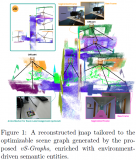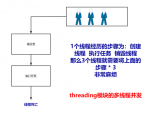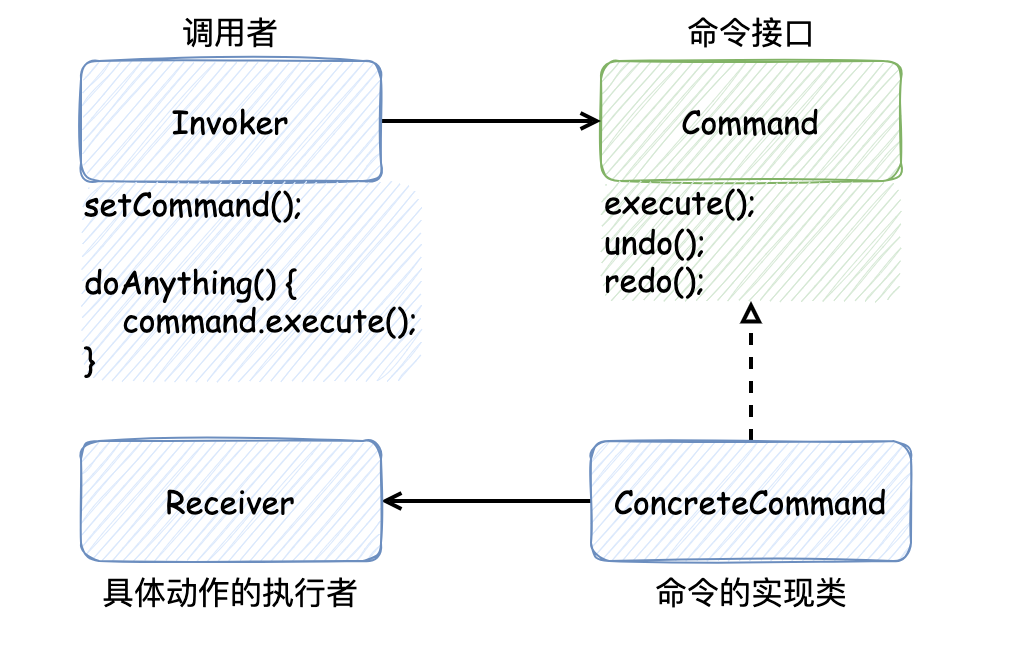每個獨(dú)立的線程有一個程序運(yùn)行的入口、順序執(zhí)行序列和程序的出口。但是線程不能夠獨(dú)立執(zhí)行,必須依存在應(yīng)用程序中,由應(yīng)用程序提供多個線程執(zhí)行控制。
每個線程都有他自己的一組CPU寄存器,稱為線程的上下文,該上下文反映了線程上次運(yùn)行該線程的CPU寄存器的狀態(tài)。
指令指針和堆棧指針寄存器是線程上下文中兩個最重要的寄存器,線程總是在進(jìn)程得到上下文中運(yùn)行的,這些地址都用于標(biāo)志擁有線程的進(jìn)程地址空間中的內(nèi)存。
線程可以被搶占(中斷)。
在其他線程正在運(yùn)行時,線程可以暫時擱置(也稱為睡眠) -- 這就是線程的退讓。
線程可以分為:
內(nèi)核線程:由操作系統(tǒng)內(nèi)核創(chuàng)建和撤銷。
用戶線程:不需要內(nèi)核支持而在用戶程序中實(shí)現(xiàn)的線程。
Python3 線程中常用的兩個模塊為:
_thread
threading(推薦使用)
函數(shù)式
調(diào)用 _thread 模塊中的start_new_thread()函數(shù)來產(chǎn)生新線程。語法如下:
_thread.start_new_thread ( function, args[, kwargs] )
參數(shù)說明:
function - 線程函數(shù)。
args - 傳遞給線程函數(shù)的參數(shù),他必須是個tuple類型。
kwargs - 可選參數(shù)。
import _thread, time# 定義線程函數(shù)def print_time(threadName, delay):
count = 0 while count < 5: ? ?
time.sleep(delay)
count += 1
# 返回當(dāng)前時間的時間戳(1970紀(jì)元后經(jīng)過的浮點(diǎn)秒數(shù)), 并格式化輸出
print("{}: {}".format(threadName, time.ctime(time.time()) ))try:
_thread.start_new_thread( print_time, ("Thread-1", 2))
_thread.start_new_thread( print_time, ("Thread-2", 4))except:
print("Error")while 1: # 讓線程有足夠的時間完成 pass
E:\PyPro>python thread.pyThread-1: Thu Apr 12 09:01:56 2018Thread-2: Thu Apr 12 09:01:58 2018Thread-1: Thu Apr 12 09:01:58 2018Thread-1: Thu Apr 12 09:02:00 2018Thread-2: Thu Apr 12 09:02:02 2018Thread-1: Thu Apr 12 09:02:02 2018Thread-1: Thu Apr 12 09:02:05 2018Thread-2: Thu Apr 12 09:02:06 2018Thread-2: Thu Apr 12 09:02:10 2018Thread-2: Thu Apr 12 09:02:14 2018
類封裝式
threading 模塊除了包含 _thread 模塊中的所有方法外,還提供的其他方法:
threading.currentThread(): 返回當(dāng)前的線程變量。
threading.enumerate(): 返回一個包含正在運(yùn)行的線程的list。正在運(yùn)行指線程啟動后、結(jié)束前,不包括啟動前和終止后的線程。
threading.activeCount(): 返回正在運(yùn)行的線程數(shù)量,與len(threading.enumerate())有相同的結(jié)果。
線程模塊同樣提供了Thread類來處理線程,Thread類提供了以下方法:
run():用以表示線程活動的方法。
start():啟動線程活動。
join([time]):等待至線程中止。這阻塞調(diào)用線程直至線程的join() 方法被調(diào)用中止-正常退出或者拋出未處理的異常-或者是可選的超時發(fā)生。
isAlive():返回線程是否活動的。
getName():返回線程名。
setName():設(shè)置線程名。
import threading, time# 創(chuàng)建進(jìn)程類class myThread(threading.Thread):
# 構(gòu)造函數(shù) def __init__(self, threadID, name, counter):
threading.Thread.__init__(self)
self.threadID = threadID
self.name = name
self.counter = counter
# 重寫run()
def run(self):
print("Thread Strat:" + self.name)
print_time(self.name, self.counter, 5)
print("Thread Exit:" + self.name)
def print_time(threadName, delay, counter):
while counter:
time.sleep(delay)
print("{}: {}".format(threadName, time.ctime(time.time()) ))
counter -= 1
# 創(chuàng)建線程thread1 = myThread(1001, "Thread-1", 1)thread2 = myThread(1002, "Thread-2", 2)# 開啟線程print("Thread-1 is Alive? ", thread1.isAlive())thread1.start()thread2.start()print("Thread-1 is Alive? ", thread1.isAlive())thread1.join()thread2.join()print("Thread-1 is Alive? ", thread1.isAlive())print("exit")
E:\PyPro>python threadClass.pyThread-1 is Alive? FalseThread Strat:
Thread-1Thread Strat:
Thread-2Thread-1 is Alive? TrueThread-1: Thu Apr 12 10:15:53 2018Thread-1:
Thu Apr 12 10:15:54 2018Thread-2: Thu Apr 12 10:15:54 2018Thread-1: Thu Apr 12 10:15:55 2018Thread-1:
Thu Apr 12 10:15:56 2018Thread-2: Thu Apr 12 10:15:56 2018Thread-1: Thu Apr 12 10:15:57 2018Thread Exit:
Thread-1Thread-2: Thu Apr 12 10:15:58 2018Thread-2: Thu Apr 12 10:16:00 2018Thread-2: Thu Apr 12 10:16:02 2018Thread Exit:
Thread-2Thread-1 is Alive? Falseexit
不難發(fā)現(xiàn),線程是通過start()函數(shù)激活,而不是對象建立時激活的!
線程同步
多線程的優(yōu)勢在于可以同時運(yùn)行多個任務(wù)(至少感覺起來是這樣)。但是當(dāng)線程需要共享數(shù)據(jù)時,可能存在數(shù)據(jù)不同步的問題。
使用 Thread 對象的 Lock 和 Rlock 可以實(shí)現(xiàn)簡單的線程同步,這兩個對象都有 acquire 方法和 release 方法,對于那些需要每次只允許一個線程操作的數(shù)據(jù),可以將其操作放到 acquire 和 release 方法之間。
import threading, time# 創(chuàng)建鎖threadLock = threading.Lock()# 創(chuàng)建線程列表threads = []class myThread(threading.Thread):
def __init__(self, threadID, name, counter):
threading.Thread.__init__(self)
self.threadID = threadID
self.name = name
self.counter = counter
def run(self):
print("Thread Start: " + self.name)
# 獲取鎖,同步線程
threadLock.acquire()
print_time(self.name, self.counter, 3)
# 釋放鎖,開啟下一個線程
threadLock.release()
print("Thread Exit: " + self.name)
def print_time(threadName, delay, counter):
while counter:
time.sleep(delay)
print("{}: {}".format(threadName, time.ctime()))
counter -= 1
# 創(chuàng)建線程thread1 = myThread(1001, "Thread-1", 1)thread2 = myThread(1002, "Thread-2", 2)# 開啟線程thread1.start()thread2.start()# 添加線程列表threads.append(thread1)threads.append(thread2)# 等待所有線程完成for t in threads: t.join()print("exit")
E:\PyPro>python synchronize.pyThread Start: Thread-1Thread Start: Thread-2Thread-1: Thu Apr 12 11:00:49 2018Thread-1: Thu Apr 12 11:00:50 2018Thread-1: Thu Apr 12 11:00:51 2018Thread Exit: Thread-1Thread-2: Thu Apr 12 11:00:53 2018Thread-2: Thu Apr 12 11:00:55 2018Thread-2: Thu Apr 12 11:00:57 2018Thread Exit: Thread-2exit
線程優(yōu)先級隊列
Python 的 Queue 模塊中提供了同步的、線程安全的隊列類,包括FIFO隊列Queue,LIFO隊列LifoQueue,和優(yōu)先級隊列 PriorityQueue。
這些隊列都實(shí)現(xiàn)了鎖原語,能夠在多線程中直接使用,可以使用隊列來實(shí)現(xiàn)線程間的同步。
Queue 模塊中的常用方法:
Queue.qsize() 返回隊列的大小
Queue.empty() 如果隊列為空,返回True,反之False
Queue.full() 如果隊列滿了,返回True,反之False
Queue.full 與 maxsize 大小對應(yīng)
Queue.get([block[, timeout]])獲取隊列,timeout等待時間
Queue.get_nowait() 相當(dāng)Queue.get(False)
Queue.put(item) 寫入隊列,timeout等待時間
Queue.put_nowait(item) 相當(dāng)Queue.put(item, False)
Queue.task_done() 在完成一項工作之后,Queue.task_done()函數(shù)向任務(wù)已經(jīng)完成的隊列發(fā)送一個信號
Queue.join() 實(shí)際上意味著等到隊列為空,再執(zhí)行別的操作
import queue, threading, timeexitFlag = 0# 創(chuàng)建鎖queueLock = threading.Lock()# 創(chuàng)建隊列workQueue = queue.Queue(10)class myThread(threading.Thread):
def __init__(self, threadID, name, q):
threading.Thread.__init__(self)
self.threadID = threadID
self.name = name
self.q = q
def run(self):
print("Thread Start: " + self.name)
process_data(self.name, self.q)
print("Thread Exit: " + self.name)
def process_data(threadName, q):
while not exitFlag:
queueLock.acquire()
if not workQueue.empty():
data = q.get()
queueLock.release()
print("{} processing {}".format(threadName, data))
else:
queueLock.release()
time.sleep(1)threadList = ["Thread-1", "Thread-2", "Thread-3"]nameList = ["One", "Two", "Three", "Four", "Five"]threads = []threadID = 1# 創(chuàng)建新線程for tName in threadList:
thread = myThread(threadID, tName, workQueue) thread.start() threads.append(thread)
threadID += 1# 填充隊列queueLock.acquire()print
("隊列填充中>>>>>>>>>>>>>>")time.sleep(1)for word in nameList: workQueue.put(word)print("隊列填充完畢>>>>>>>>>>>>>>")queueLock.release()# 等待隊列清空while not workQueue.empty(): pass# 通知線程退出exitFlag = 1# 等待所有線程完成for t in threads: t.join()print("exit")
E:\PyPro>python queueue.pyThread Start: Thread-1Thread Start: Thread-2Thread Start: Thread-3隊列填充中>>>>>>>>>>>>>>隊列填充完畢>>>>>>>>>>>>>>Thread-3 processing OneThread-1 processing TwoThread-2 processing ThreeThread-3 processing FourThread-1 processing FiveThread Exit: Thread-2Thread Exit: Thread-1Thread Exit: Thread-3exit
源碼中其實(shí)實(shí)現(xiàn)了三個進(jìn)程讀取同一個隊列,按照先進(jìn)先出原則實(shí)現(xiàn)鎖定。
用start方法來啟動線程,真正實(shí)現(xiàn)了多線程運(yùn)行,這時無需等待run方法體代碼執(zhí)行完畢而直接繼續(xù)執(zhí)行下面的代碼。通過調(diào)用Thread類的start()方法來啟動一個線程,這時此線程處于就緒(可運(yùn)行)狀態(tài),并沒有運(yùn)行,一旦得到cpu時間片,就開始執(zhí)行run()方法,這里方法 run()稱為線程體,它包含了要執(zhí)行的這個線程的內(nèi)容,Run方法運(yùn)行結(jié)束,此線程隨即終止。
join的作用是保證當(dāng)前線程執(zhí)行完成后,再執(zhí)行其它線程。join可以有timeout參數(shù),表示阻塞其它線程timeout秒后,不再阻塞。。一般線程的start()之后,所有操作結(jié)束后都要進(jìn)行thread.join()。確保語句的輸出是join()后面的程序是等線程結(jié)束后再執(zhí)行的。
-
寄存器
+關(guān)注
關(guān)注
31文章
5425瀏覽量
123646 -
cpu
+關(guān)注
關(guān)注
68文章
11051瀏覽量
216240 -
線程
+關(guān)注
關(guān)注
0文章
507瀏覽量
20109
原文標(biāo)題:十分鐘帶你了解 Python3 多線程核心知識
文章出處:【微信號:magedu-Linux,微信公眾號:馬哥Linux運(yùn)維】歡迎添加關(guān)注!文章轉(zhuǎn)載請注明出處。
發(fā)布評論請先 登錄
Hi3861 wifiiot_hispark_pegasus 按教程安裝python3 -m pip install build/lite 報錯
工控一體機(jī)多線程任務(wù)調(diào)度優(yōu)化:聚徽分享破解工業(yè)復(fù)雜流程高效協(xié)同密碼
一種實(shí)時多線程VSLAM框架vS-Graphs介紹

?如何在虛擬環(huán)境中使用 Python,提升你的開發(fā)體驗(yàn)~

請問如何在Python中實(shí)現(xiàn)多線程與多進(jìn)程的協(xié)作?
使用Yolo-v3-TF運(yùn)行OpenVINO?對象檢測Python演示時的結(jié)果不準(zhǔn)確的原因?
請問rt-thread studio如何進(jìn)行多線程編譯?
掌握EMC核心知識——7天倒計時!

socket 多線程編程實(shí)現(xiàn)方法
Python中多線程和多進(jìn)程的區(qū)別

迅為3A6000_7A2000核心主板龍芯全國產(chǎn)處理器LoongArch架構(gòu)
【PHYTEC AM62x開發(fā)板試用】準(zhǔn)備工作
從多線程設(shè)計模式到對 CompletableFuture 的應(yīng)用






 Python3多線程核心知識
Python3多線程核心知識










評論